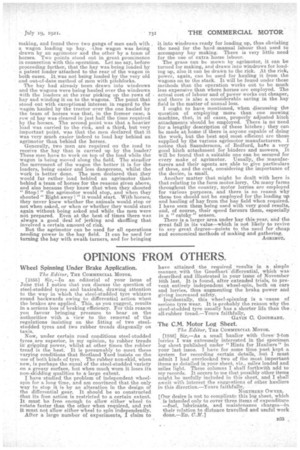OPINIONS FROM OTHERS.
Page 29

If you've noticed an error in this article please click here to report it so we can fix it.
Wheel Spinning Under Brake Application.
The Editor, THE COMMERCIAL MOTOR.
[1855] Sir, —In an editorial of your issue of June 21st I notice that you discuss the question of steel-studded tyres and taxicabs, drawing attention te the way in which the steel-studded tyre whizzes round backwards owing to differential action when the brakes are applied. This, as you suggest, results in a serious lose of braking efficiency. For this reason you favour bringing pressure to bear on the authorities' with a view to the removal of the regulations insisting on the fitting of two steelstudded tyres and two rubber treads diagonally on taxis.
Now, under certain road conditions steel-studded tyres are superior, in my opinion, to rubber treads in gripping power, whilst at other times the rubber tread is the best. It is presumably to meet these varying conditions that Scotland Yard insists on the use of both kinds of tyre. The rubber non-skid, when new, is perhaps the equal of the steel-studded variety on a greasy surface, but when much worn it loses its non-skidding qualities to a large exlent. I have studied the problem of independent wheelspin for a long time, and am convinced that the only way to stop it is by an alteration in the design of the differential gear. It should be so constructed that its free action is restricted to a certain extent. It must be free enough to allow either wheel to rotate faster than the other when required, and yet it must not allow either wheel to spin independently. After a large number of experiments, I claim to have attained the required_ results in a simple manner, with the Goodhart differential, which was described and illustrated in your issue of November lath last. It is found, after extended trials, to prevent entirely independent wheel-spin, both on cars and lorries, thus augmenting the brake power and giving increased safety.
Incidentally, this wheel-spinning is a ,cause of serious tyre wear. It is probably the reason why the steel-studded tyre usually has a shorter life than the all-rubber tread.—Yours faithfully,
GAVIN C. GOODRART.
.The C.M. Motor Log Sheet.
The Editor, TFLE COMMERCIAL MOTOR.
[I856] Sir,—As a small haulier with three' 3-ton lorries I was extremely interested in the specimen log sheet published under "Hints for Hauliers" iii your last issue. I have for some time past kept a system for recording certain details, but I must admit I had overlooked two of the most important items as detailed in your sheet, viz., miles loaded and miles light. These columns I shall forthwith add to my records. It occurs to me that possibly other items might he usefully included in this sheet, and I shall await with interest the suggestions of other hauliers in this direction.—Yours faithfully,
NORTHERN OWNER. [Our desire is not to complicate this log sheet, which
is intended only to cover three items of expenditure —fuel, lubricants, and maintenance charges—in their relation to distance travelled and useful work done.—ED. C.M.]
































